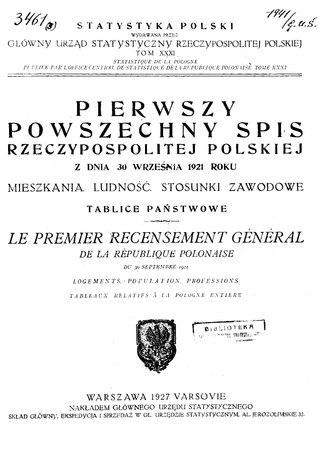Top Qs
Timeline
Chat
Perspective
1921 Polish census
From Wikipedia, the free encyclopedia
Remove ads
The Polish census of 1921 or First General Census in Poland (Polish: Pierwszy Powszechny Spis Ludności) was the first census in the Second Polish Republic, performed on September 30, 1921, by the Main Bureau of Statistics (Główny Urząd Statystyczny). It was followed by the Polish census of 1931.
Remove ads
Content
Summarize
Perspective
Due to war, not all of interwar Poland was enumerated. Upper Silesia was formally assigned to Poland by the League of Nations after the census was conducted elsewhere. Meanwhile, the conditions in eastern Galicia were still unstable and chaotic, and the census data had to be adjusted after the fact, wrote Joseph Marcus, thus leading to more questions than answers.[1] The army and personnel under military jurisdiction were not included in the results. Also, specific areas of considerable size lacked complete returns due to absence of war refugees.[2]
Entire categories considered essential today were absent from the questionnaires, subject to historic interpretation at any given time. For example, the Ukrainian ethnicity was not surveyed. The census followed all previous Habsburg censuses and surveyed only the Rusyns (as Ruthenes) with the only possible distinguishing factor for Ukrainians being religion. Within a single total number of Ruthenes (narodowość rusińska), separate categories existed only for Greek Catholics (68.4 percent or 2,667,840 of them) and Orthodox Christians (31 percent or 1,207,739 of the total),[page 80] but did not address language in the same way as the next Polish census of 1931. Neither the Ukrainians, Carpatho-Rusyns (or Rusnaks), nor Polesians were defined by their name. The categories listed in the census included verbatim: Narodowość: polska (polonais), rusińska (ruthènes), żydowska (juifs), białoruska (biėlorusses), niemiecka (allemands), litewska (lithuaniens), rosyjska (russes), tutejsza (indigène), czeska (tchèques), inna (autre), niewiadoma (inconnue).[3]
Some scholars claim that minorities had been undercounted, with some claiming as much as 40% of Poland's population was a minority, 18 percent Ukrainian, 10 percent Jewish, 6 percent Byelorussian, and 5 percent German.[4]
Remove ads
Results
Summarize
Perspective
Nationality
Religion
Source:[3]
Remove ads
References
External links
Wikiwand - on
Seamless Wikipedia browsing. On steroids.
Remove ads

